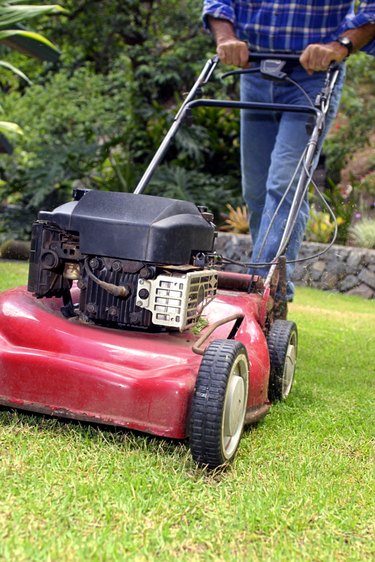
Gas-powered lawnmowers are driven by combustion engines similar in all ways to those that power motor vehicles. The term "compression" refers to the pressure that builds up inside the piston chamber, as a combination of fuel and air is squeezed, and a spark is applied. The ensuing explosion drives the piston outward, and causes the crankshaft to spin. A loss of compression may result when the pistons are worn, the seals around your pistons are worn, or a push rod has become bent or broken.
Step 1
Locate the ignition wire that runs from your spark plug to your distributor. Remove the plug end of the wire from its seat atop the spark plug, by grasping it firmly at the base and pulling. Try turning the spark plug by hand. If the plug is loose, compression can be leaking through the hole it is creating. Use your ratchet set to tighten the spark plug completely, then try starting the engine again.
Video of the Day
Step 2
Inspect the bolts that hold the top of your cylinder head in place. The cylinder head bolts are typically set around the outer edge of the head. If these bolts have loosened, they can allow compression to leak out from the cylinder. Use your ratchet set to tighten any loose bolts, and start the engine again.
Step 3
Remove the cylinder head cover and inspect the push rods and valve lifters for broken parts or bends. If any of these parts has been damaged, it can prevent a tight seal from forming within the cylinder. This faulty seal lowers compression. If there are any broken or damaged parts, they must be replaced.
Step 4
Determine whether worn valves or worn piston rings are the cause of your low compression. Remove the spark plug, and pour a cap full of W30 motor oil into the top of the open cylinder. Place your compression tester over the spark plug hole. Disconnect the ignition coil, and locate the crankshaft at the front of the engine.
Step 5
Use your wrench to grasp and turn the crankshaft with your tester in place. Read the tester gauge, and compare the results to the normal compression range as stated by your lawnmower manufacturer. If the oil solves the compression problem, the problem is in the rings. If it does not, the problem may lie with a worn valve.
Video of the Day